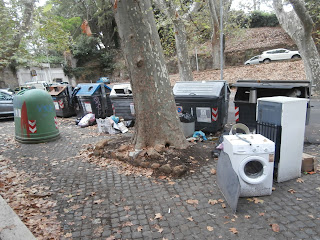Saturday, 2 October 2021
7-day average of new infections exceeds 1,000 in Poland (in 2020 it hit the
mark on 25 September, 7 days earlier), but is 37% lower than on 2 October in
2020. I sadly predict the 2,000 hurdle will be crossed on 13 October. I will
resume the pandemic diary published in bi-weekly intervals once it reaches
3,800 (i.e. 1 infection per 10,000 citizen detected daily).
Tuesday, 5 October 2021
According to my estimations (no exact figures available) 80% of Warsaw’s 80+
population have received at least one dose of any vaccine against COVID-19. The
calculations do not take into account inhabitants of the city registered (zameldowani) is their home towns. Nevertheless,
new infections keep rising in Warsaw, albeit not as fast as in a poorly
vaccinated Lubelszczyzna province.
Sunday, 10 October 2021
The Polish government seems to aim at possibly many people getting immunity
naturally, or encouraging people to get vaccinated by letting them see other
unvaccinated people seriously ill or dying.
In 2020 on masks became mandatory outdoors. Let’s cherish the lack of that
senseless obligation, at least for the time being.
Thursday, 14 October 2021
I get it wrong, by just one day. 7-day average of new infections exceeds 2,000
(in 2020 it hit the mark on 6 October, 8 days earlier), but is 59% lower than
on 14 October 2020. I predict the 3,000 hurdle will be crossed on 22 October.
Saturday, 16 October 2021
The Baltic countries reported around 1 case per 1,000 citizens in recent days.
The pandemic seems to be in overdrive there. With appropriate testing (a
daydream) Poland can conceivably reach the same level.
Wednesday, 20 October 2021
New infections in Poland up by 111% week-on-week. I get in wrong again, this
time the 7-day average of new infections exceeds 3,000 (in 2020 it hit the mark
on 10 October, 10 days earlier), but is 61% lower than on 20 October 2020. I make
no more predictions, but believe the 7-day average crosses 5,000 before the end
of October. The wave is bearing down on Warsaw.
Thursday, 21 October 2021
Latvia is the first European country to go into lockdown this autumn. Schools,
HoReCa and entertainment sector will be closed for everyone until 15 November.
Then they will be reopened, but only to Green Pass holders.
Friday, 22 October 2021
7-day average of new infections gets above 3,800, i.e. above 1 detected
infection per 10,000 citizens daily. Time to resume to timeline and brace for
the bad times.
Saturday, 23 October 2021
The Polish government was very intent on imposing restrictions during the
previous waves. These days it takes a wait-and-see approach and only steps up
enforcing the indoor masking mandate. Even in districts where 1 in 1,000
citizens is tested positive daily no measures are taken. A disaster looms
ahead.
Sunday, 24 October 2021
Romania and Bulgaria, the least vaccinated countries in the EU, resort to use
of Green Passes as obligatory to enter public facilities. According to their
governments, the moves are necessitated by spikes in new infections in both
countries. Long queues are witnessed outside vaccination centres.
Monday, 25 October 2021
Romania, Ukraine, Baltic Countries – in all those poorly vaccinated post Soviet
countries the current wave is higher and deadlier than previous ones. Poland is
in for the same fate.
Tuesday, 26 October 2021
The 7-day average of new infections exceeds 5,000 (in 2020 it hit the mark
on 15 October, 11 days earlier), but is 54% lower than on 26 October 2020. I
predict the 10,000 hurdle will be crossed on 4 November (due to limited tested
around All Saints’ Day).
Wednesday, 27 October 2021
In some districts in eastern Poland more than 12 new infections per 10,000
residents are reported, which means around 1 in 800 person is tested positively
daily. No new restrictions are there in place, locals have not got convinced to
get vaxxed. How long before the wave burns out.
Thursday, 28 October 2021
A good day. My parents receive a booster. They will be safer during the awful
weeks ahead.
Friday, 29 October 2021
On 19 March 2021 I predicted the total number of infections in Poland would hit
3,000,000 on 8 May 2021. Fortunately, I was wrong, by some 170,800 cases, or by
174 days. Hereby I predict the number of new registered infections hits
4,000,000 on 26 January 2022.
Saturday, 30 October 2021
The worldwide official death toll hits 5,000,000. A round number has little to
do with reality, as actual the number of fatalities of COVID-19 hit eight
digits months ago.
Sunday, 31 October 2021
And customary month-end report of the sluggish pace of vaccinations in Poland.
1. Vaccine uptake in age groups – I believe the data reported by ECDC are
wrong, since booster doses are reported as first doses, hence high first dose uptakes
in 80+ and 70-79 age groups. I hope by the end of November it gets sorted out.
2. Vaccination status in the entire population of Poland


















